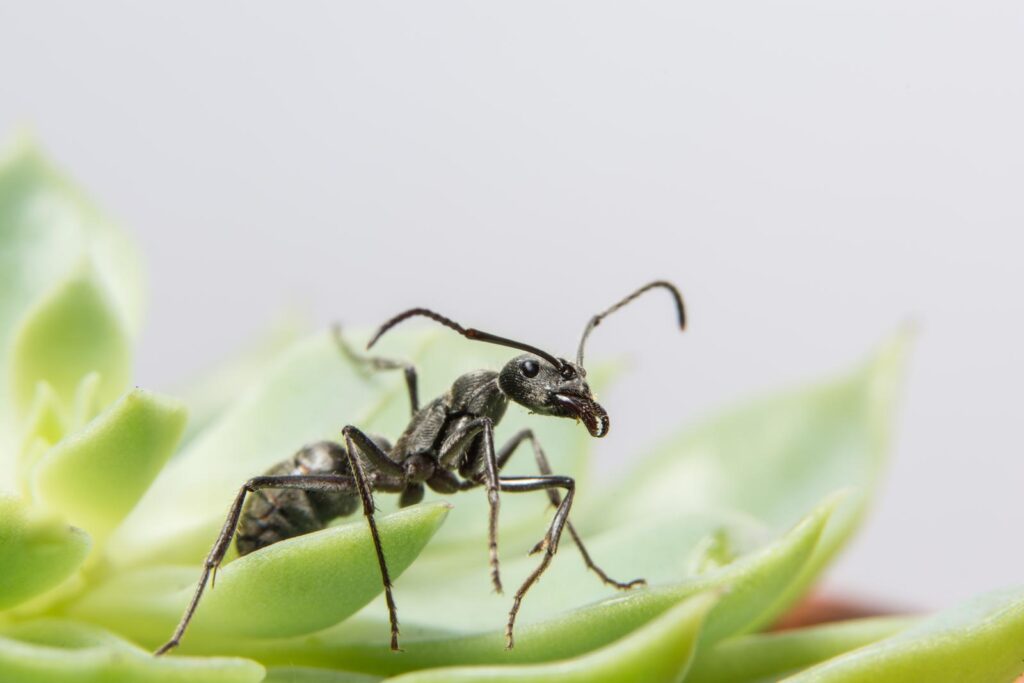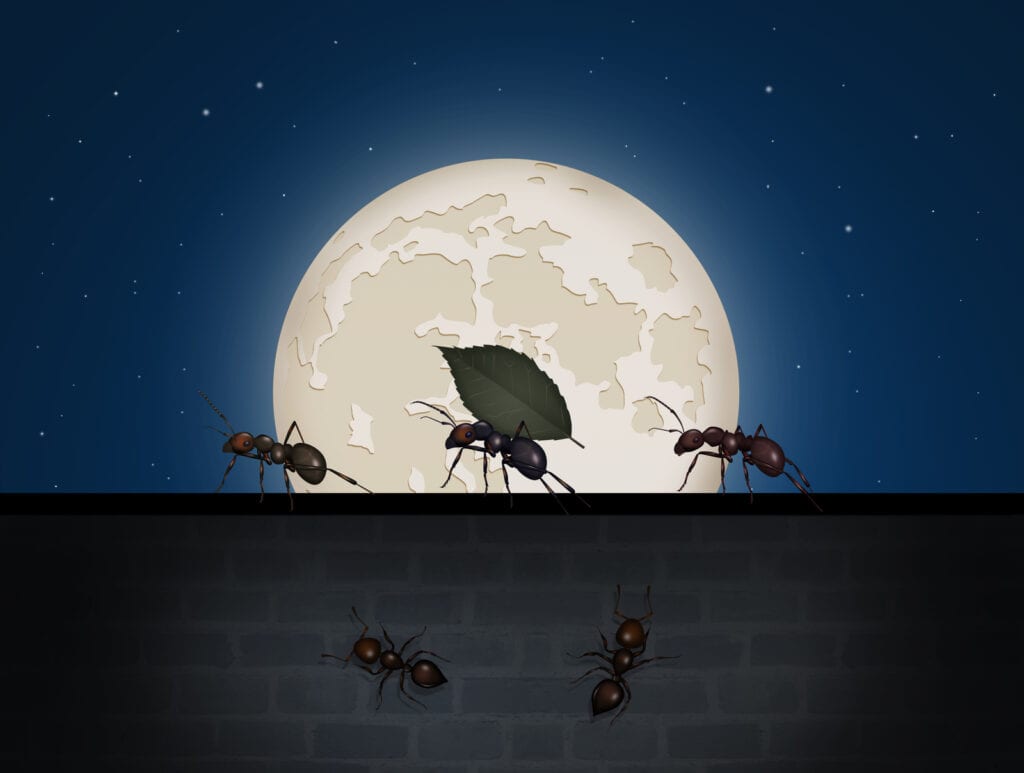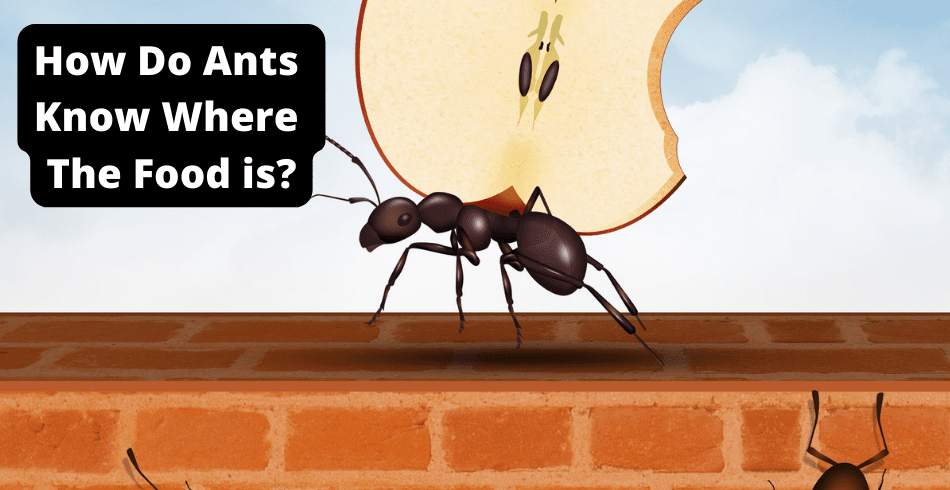We’ve all been there – you’ve set up a nice picnic, and within minutes, it seems like the food is swarming with ants! How are they able to find it so fast? We often ask ourselves how ants know where the food is.
Well…
Ants know where the food is because worker ants scout the environment. Ants use their advanced olfactory (smell) capability found in the antenna to locate their food. When a worker finds the food, it carries a tiny piece back to the nest, leaving a pheromone trail in its path for fellow ants to follow.
While that’s just the quick answer, In the rest of this article, you’ll learn:
- How Ants Find Food
- What ants do with that food
- How do ants find far-away food
- Do ants call their friends once they find food
- How do ants remember where they live?
- How do ants pick a path?
… And so much more

How do ants find food?
It is the responsibility of workers to look for food to feed the colony. The scout ants forage for food and water in the nest areas and detect it using the odor receptors in the antenna. On successfully locating the food, scouts return to the nest to recruit nestmates.
In its search for food and water, the forager ant leaves a chemical trail to the food for others to follow.
It’s this trail of chemical scents other worker ants follow to the food or water source.
Ants are highly successful in their food search.
Why?

They rely on one of the most advanced senses of smell among insects.
Even though most ants species scavenge in groups, some don’t.
Some giant ants, such as the Dinoponera Australis, forage individually and do not swarm the food source when they find one. (Source1, Source2)
What do ants do with the food they collect?
Ants look for food to meet their nutritional requirements and those of others in the colony. Workers eat sugars for energy to make and maintain the nest effectively. They also forage dead insects to get proteins. These proteins are usually saved for the Queen and Larvae.
The ant’s stomach’s anatomy helps the ants achieve these two key food objectives.
An ant’s gaster serves two purposes, food storage, and digestion.
When an ant eats, food is initially stored in the midgut in liquid form.
When the body needs nourishment, the stored food moves to the hindgut.
Here essential nutrients are absorbed and waste excreted.
The second purpose of the liquid food stored in the midgut is to feed the other ants in the colony through mouth-to-mouth exchange.
In other instances, ants can transport a large piece of food (especially a protein meal) to the nest for future consumption.
Ants use these techniques to deliver surplus food back to the nest to feed the queen and the larvae. (Source)

How do ants find food from far away?
Different types of ants locate far away food by combining random scavenging with the help of their smell organs. Depending on the species, some ants explore only a few (2-3) meters from the nest (e.g., black ants). Others travel far, like Carpenter ants that forage up to 30 meters.
Other ants go as far as 30-60 meters (e.g., desert ants).
Long distances are observed in habitats experiencing food scarcity, such as deserts.
In addition to mastering long scavenging routes, some ants tap into the wind and pick tiny bits of “food smells” from it.

Ants, especially those that scavenge far from the nest, combine sight and smell to find food.
However, the olfactory capabilities account for most of an ant’s ability to discover far-away food.
Ants that forage short distances make nests close to validated food sources.
That’s one reason ants are a common pest in your home, and trash and spillovers are an easy food source. (Source1, Source2)
Do ants call other ants when they find food?
Ants are social creatures and seek assistance from nestmates when they find food. In most species, workers look for food in groups. Successful scouts leave a scented trail along the ground when they find food. Each ant makes a pheromone trail by dragging the abdomen to the ground.
Other workers pick up the pheromones to find the food and lay down more pheromones.
This way, more ants follow the scent trail to the food.
If the walk back to the nest is frantic, it signals to the others that the food source is in plenty.
This is why you see ants invading and carrying food away quickly.

How long does it take for ants to smell food?
Several factors affect how fast ants smell food. These include the intensity of the food smell molecules, distance to the food, and whether an ant has had a previous encounter with the food. In harsh environments, ants pick food odors in as little as four minutes.
Ants have a strong sense of smell and a good memory for food.
Studies have shown that ants register and memorize, for a lifetime, as many as 14 different food odors.
Due to food odor memorization, they smell faster a food item they have encountered before than a new one. (Source)
Ants prefer sugary foods to other food types and will smell and locate sweeter foods faster than others.

Do ants know where they are going?
Workers leave the nests every day to scout the environment for food. The outbound food errands are primarily a function of the ant’s sense of smell. Locating the nest while carrying food back is less straightforward. Thus, ants use visual cues, landmarks, and journey memories to return to the colony.
An ant uses its smell senses located in its antenna when moving toward food.
After discovering the food, the ant has to walk back to the colony.
The female ants use a combination of pheromones and visual memories to return to their nest. (Source)

How do ants decide where to go?
Biologically, workers are wired to perform food searches, and they pick smells by the olfactory receptors and use the information to go to food sites. Most ant species are monogenic, and ant roles in a colony are distinct and nonreplicated. Biological factor largely influences where ants go or behave.
- Female workers make and maintain nests and feed the colony.
- Scouting and Foraging ants look for food.
- Workers only leave the nest after scouts return successfully with food and signal it’s safe to venture outside the nest.
Ants share scavenging and nest activities through pheromones.
When workers detect danger, they emit an odor that triggers others to swarm the location where the threat is detected.
Other ant types, such as the unmated female queens and males, also respond to their hormonal code.
When reproduction time arrives, usually in summer and autumn, they leave the nest for the nuptial flight.
Successfully mated queens proceed to set up nests, and males die a short while after mating.

How do ants remember where they live?
Species that do not venture very far from the nest primarily use pheromone chemical trails to find their way back to the nest. Ants that travel quite a distance from the nest use path memory and sense the landmarks to navigate their way back.
Visual memories of the path feature partly to enable the walk back to the nest.
Ants that scavenge during the day utilize the sun’s position as well.
Ants with high nest locating precision possess an internal step-counting capability.
These observations were arrived at in an experiment with Spanish desert ants.

